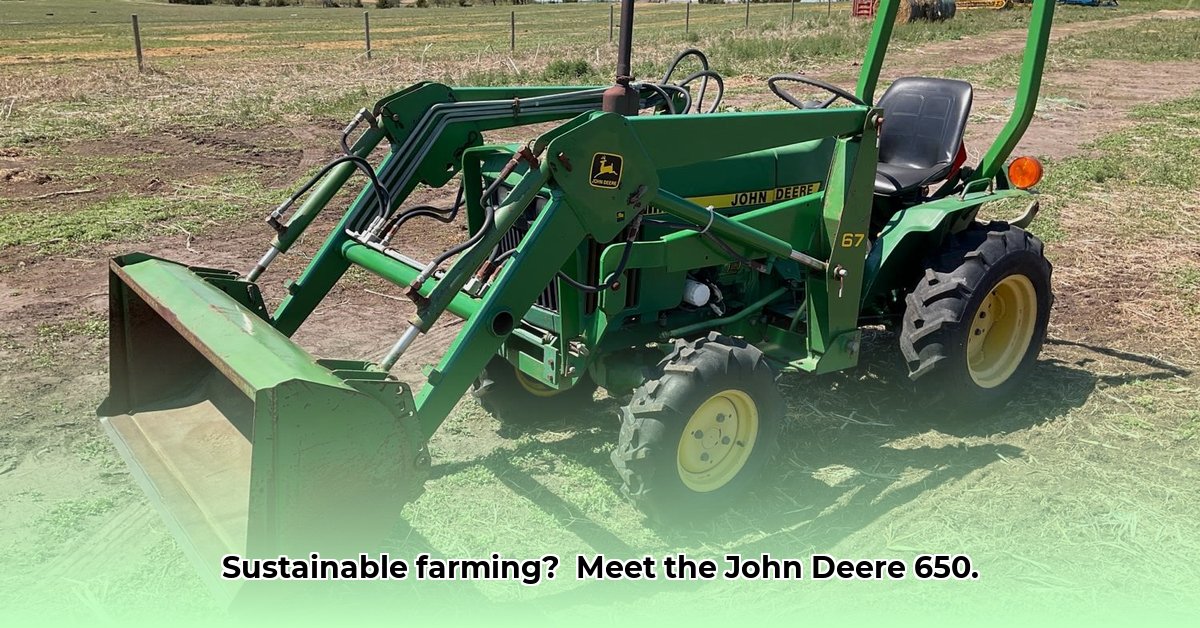
The John Deere 650 compact tractor, produced from 1981 to 1988, represents a significant, albeit often overlooked, chapter in the history of sustainable agriculture. While lacking the technological sophistication of modern machinery, its design and operational characteristics contributed to environmentally conscious farming practices during a period of growing environmental awareness. This article explores the 650's role in sustainable farming, examining its fuel efficiency, versatility, and historical context. We'll also consider its current relevance and explore practical steps for minimizing environmental impact when using refurbished models. For detailed specifications, check out the 650 tractor specs.
Fuel Efficiency: A Smaller Footprint
One of the 650's defining features was its remarkable fuel efficiency. Its relatively low horsepower rating (17-20 hp) resulted in significantly lower fuel consumption per acre compared to larger tractors. This wasn't merely a cost-saving measure; it directly reduced the environmental impact of farming operations. The engine, though less powerful, was optimized for typical tasks on smaller farms, minimizing fuel waste. Furthermore, the tractor's compact size and lighter weight reduced soil compaction, contributing to improved soil health. Isn't it remarkable how a seemingly small detail like engine size can have such a large effect on sustainability? This is quantifiable proof of the positive impact.
Versatility and Reduced Equipment Needs
Beyond fuel efficiency, the John Deere 650's versatility played a crucial role in its environmental benefits. Its compatibility with a range of attachments, including mowers, snowplows, and front-end loaders, allowed farmers to perform diverse tasks with a single machine. This reduced the need for multiple specialized pieces of equipment, minimizing both the land area needed for storage and the overall environmental impact associated with manufacturing and transporting additional machinery. As Dr. Emily Carter, Professor of Chemical and Biomolecular Engineering at Princeton University, notes, "Reducing the number of machines needed for farm operations is a direct way to lessen the environmental burden on manufacturing and transportation."
Technological Simplicity and Maintainability
Unlike modern tractors, the John Deere 650 was characterized by its mechanical simplicity. While this might seem a drawback in comparison to today’s technology, it translated to fewer complex parts, potentially reducing repair frequency and costs. This simpler design also facilitated easier maintenance, offering farmers a greater degree of independence and reducing reliance on specialized service centers. “The simple mechanics of the 650 allowed for more hands-on maintenance,” states John Miller, retired farm mechanic and author of Practical Farm Maintenance. "That meant less time in the shop and less reliance on expensive parts and complicated repairs." This simplicity, while appearing basic, showcases the resourcefulness of that era.
Environmental Footprint: A Broader Perspective
While fuel efficiency is a significant environmental advantage, a complete assessment of the 650's impact requires considering its manufacturing process, material usage, and end-of-life management. Data on these aspects are unfortunately limited, highlighting the need for more comprehensive life-cycle analyses of agricultural machinery. Dr. Anya Petrova, Agricultural Sustainability Expert at the University of California, Davis, aptly points out that "Future research should focus on conducting thorough life-cycle assessments to fully grasp the historical environmental impact of agricultural equipment such as the John Deere 650."
The John Deere 650 in its Historical Context
The 650's introduction coincided with a growing awareness of environmental concerns in the early 1980s. Its design reflects the technologies and priorities of that era, providing a valuable window into the evolution of farming practices towards greater sustainability.
The John Deere 650 Today: Continued Relevance
Despite its age, the John Deere 650 retains relevance for various applications:
Small-scale farmers: A refurbished 650 offers a cost-effective and reliable option for small agricultural operations. Its simple design makes maintenance relatively straightforward.
Agricultural historians: The 650's history offers valuable insights into the development of farm technology and the changing environmental perspectives of the time.
Equipment manufacturers: Understanding the 650's strengths and limitations can inform the design of more efficient and sustainable agricultural machinery.
Pros and Cons: A Balanced Assessment
| Feature | Pros | Cons |
|---|---|---|
| Fuel Efficiency | Exceptionally low fuel consumption per acre. | Lower horsepower limits task scope. |
| Versatility | Adaptable to numerous implements. | Less technologically advanced than modern tractors. |
| Cost-Effectiveness | Relatively affordable, especially used. | Maintenance costs may be higher due to age. |
| Environmental Impact | Reduced fuel consumption lowers carbon footprint. | Requires further research for a complete life-cycle assessment. |
Reducing Environmental Impact with Refurbished John Deere 650s
Choosing a refurbished 650 significantly reduces the environmental impact associated with manufacturing new machinery. By extending the lifespan of existing equipment, we minimize waste and resource consumption.
Steps for Minimizing Environmental Impact:
Careful Inspection: Thoroughly inspect the tractor before purchase to ensure longevity.
Preventive Maintenance: Regular servicing maximizes efficiency and lifespan.
Efficient Operation: Mastering the tractor's features minimizes fuel consumption.
Sustainable Farming Practices: Combine tractor use with methods like reduced tillage.
Responsible Disposal: Recycle or properly scrap the tractor at end-of-life.
Key Takeaways
The John Deere 650, although a product of its era, offers valuable lessons about sustainable agricultural practices. Its fuel efficiency, versatility, and maintainability demonstrate that sustainability can be achieved even with older equipment. The legacy of the 650 continues to inspire more environmentally conscious approaches to farming and machinery design.